Financial Stability Review – April 2018 Box A: Low Interest Rates and Asset Price Risk
Low global policy rates have boosted a broad range of asset prices and encouraged financial risk-taking. These responses are part of the normal mechanisms through which accommodative monetary policy stimulates the economy. However, the historically low level of interest rates and the protracted length of time they have been at those levels have led to particularly strong responses of asset prices. Metrics of many assets' valuation, which are contingent on the low risk-free interest rates, are elevated relative to history. In addition, investor compensation for bearing many types of risk has fallen to record low levels, and some investors have significantly increased their risk profiles.
A sharp increase in long-term risk-free interest rates toward historically normal levels could result in widespread asset price falls if it is not accompanied by stronger growth. If the increase in interest rates is triggered by stronger growth expectations then higher expected income flows could hold up asset valuations despite higher discount rates. However, valuations for fixed income securities could fall sharply if interest rates rise substantially because of higher realised or expected inflation, while valuations for assets more broadly could fall if risk premia return to historically more normal levels.
While a host of regulatory and other changes have made the financial system and, in particular, banks more robust since the financial crisis, a large synchronised fall in asset prices could test this resilience. Despite some improvements in transparency, there is significant uncertainty about the ultimate exposure and response of different types of investors to such asset price falls. Notably, there is little information on the extent of leverage, which would amplify losses, of non-prudentially regulated financial institutions.
Low Interest Rates, Asset Valuations, the Price of Risk and Risk-taking Behaviour
The very low policy rates and unconventional monetary policies implemented around the world over the past decade have contributed to yields on government bonds falling to exceptionally low levels (Graph A1). As a result, prices for a broad range of assets, including equities, corporate bonds and commercial real estate, have risen because risk-free interest rates are central to their valuation. In addition, the compensation demanded for bearing risk has fallen in a range of markets given the stability in financial market and economic outcomes in recent years and investors' willingness to hold riskier assets as they seek higher returns.[1] This is particularly evident in corporate bonds where spreads to government securities have narrowed to low levels (Graph A2).
Various aspects of some investors' strategies point to possible mechanisms that could increase the response to, or amplify, a financial shock.
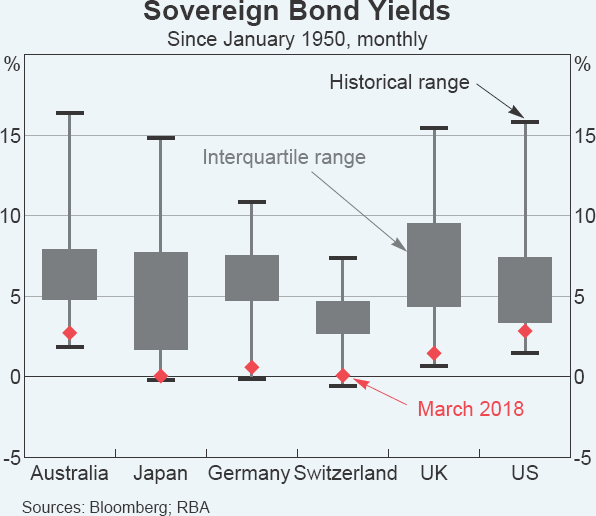
- Some investors have moved into lower-rated assets, increasing their credit risk exposures. A notable example of this has been investors' willingness to hold BBB-rated bonds earning low interest rates, which has made their issuance attractive to corporates (Graph A3).[2] At the same time, the covenants attached to speculative-grade corporate loans in Asia, Europe and North America have been loosening.[3],[4] With investors accepting both lower credit quality and compressed spreads, they are receiving historically low compensation for taking on credit risk.
- Some investors have moved into relatively illiquid assets or markets where liquidity has not been tested in times of stress. This increases the risk that investors might be unable to meet their liquidity needs (except by selling at heavily discounted prices). For example, life insurers have increased their asset allocation towards illiquid assets such as commercial property, infrastructure financing and mortgage loans. Retail investors' holdings of corporate bonds have also increased through the rapid growth of bond investment funds.
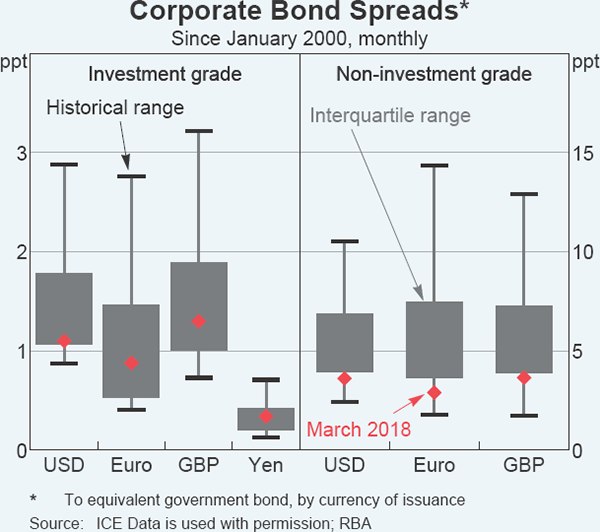
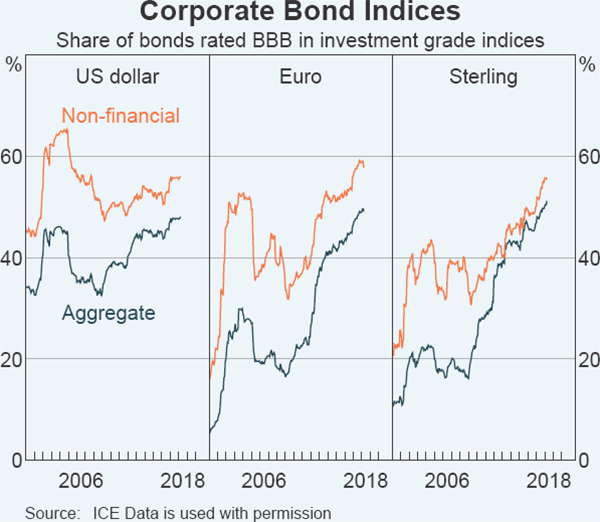
- Some investors have gone beyond their traditional risk mandates or areas of expertise. This increases the risk that investors might fail to appropriately assess and price their risk. For example, in countries where interest rates are very low, such as Japan, some banks and insurers have expanded their activities in foreign jurisdictions where interest rates and spreads are higher. Further, demand for complex, opaque and/or risky instruments, such as collateralised loan obligations and short-volatility exchange-traded products, has been strong.
- Investors are holding bonds with longer maturities. This provides a natural hedge for investors with long-dated liabilities (such as pension funds and life insurers) but for other investors it increases their exposure to interest rate risk. The average duration of outstanding bonds has risen in many markets since the early 2000s (Graph A4). While longer tenor bonds reduce refinancing risk for borrowers, they make investors' asset returns more sensitive to interest rate changes. Bond prices at all maturities have also become more responsive to interest rate changes due to the lower level of yields.
- Leverage remains prevalent in the financial system. While the global banking sector has significantly reduced its leverage since the financial crisis, leverage remains high for some other institutions and may have even increased for some. However, there is little transparency on this leverage, which adds to uncertainty. Partial information suggests leverage could still be an important amplification mechanism: there are some reports of increasing leverage among hedge funds in the United States (including through derivatives) which is at a high level for large funds (about 15 times), and equities margin debt balances relative to market capitalisation are above pre-crisis levels in the United States.[5]
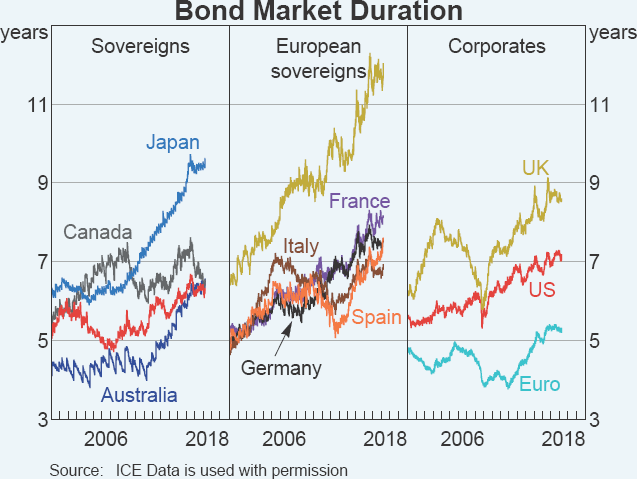
Asset Price Response
While banks should be more resilient to asset price falls given regulatory reforms, the factors outlined above suggest that this may not be the case for all other types of investors. Given the multitude of changes in institutional structures, investors' asset holdings and market dynamics, it remains uncertain how different classes of investors will be affected by, and respond to, asset price falls. Notably, they could be tested by synchronised falls in asset prices. Frequently, prices of certain assets, in particular, sovereign bonds, move inversely with those of riskier assets. However, given high valuations for a broad range of assets are being underpinned by low risk-free interest rates (high sovereign bond prices), a rise in sovereign yields could result in synchronised asset price falls.
One recent example of such synchronised asset price falls triggered by rising risk-free rates occurred in mid 2013 after the US Federal Reserve unexpectedly announced a tapering of its bond-buying program (the ‘taper tantrum’). While this episode ultimately was relatively benign, it highlights that broad-based asset price falls can be triggered by a sudden rise in sovereign yields (Graph A5). More sustained or larger price falls could have a greater impact.
Alternatively, an adverse shock could prompt a sudden reassessment of the current very low levels of risk premia, leading to sharp price falls for a range of assets. This has been true of past episodes of sharply rising risk premia (Graph A6).[6] While prices for sovereign bonds tend to rise in such episodes, the falls in prices for riskier assets have historically been quite large.
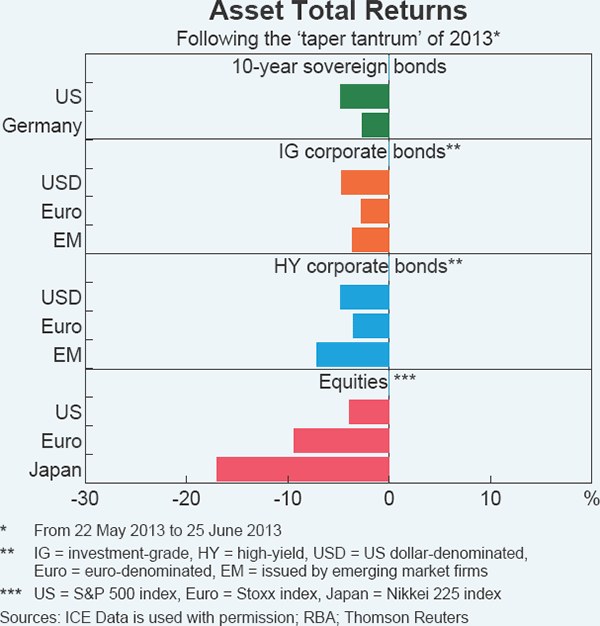
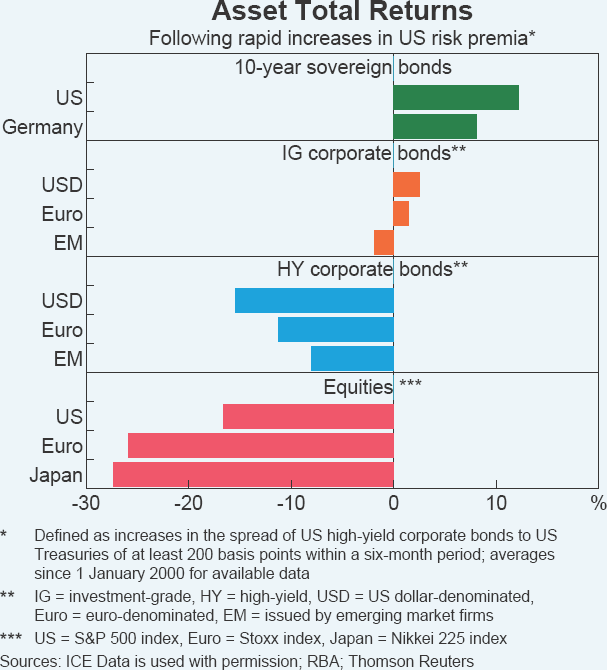
Footnotes
Many commentators refer to this phenomenon as the ‘search for yield’. When originally coined, this phrase was used in a narrower sense, referring to financial institutions that offer guaranteed nominal returns (such as defined benefit pension funds and some life insurers) shifting into riskier assets to maintain nominal returns as interest rates fall. See Rajan R (2005), ‘Has Financial Development Made the World Riskier?’, Proceedings of the Jackson Hole Conference organised by the Federal Reserve Bank of Kansas City. [1]
This shift can also be seen on the balance sheets of different investor types. For example, the share of US and European life insurers' bond portfolios with a BBB or lower rating has risen over the past decade from one-quarter or less to at least one-third. See International Monetary Fund (2017), ‘Is Growth at Risk?’, Global Financial Stability Report, October. [2]
See Moody's (2018), ‘Covenant quality score for Asian high-yield bonds falls to weakest level on record’, 24 January; Moody's (2017), ‘Speculative-grade non-financial corporates – EMEA: Covenant-lite returns with a vengeance, eroding investor protection’, 19 June; and Moody's (2018), ‘North American loan covenant quality touches weakest level in third quarter as covenant erosion continues apace’, 18 January. [3]
This is consistent with the sharp rise in US leveraged loans – which are typically to non-investment grade companies – that are classed as ‘covenant-lite’, at a time of strong growth in US leveraged loans more broadly. [4]
On increasing hedge fund leverage see: Board of Governors of the Federal Reserve (2018), ‘Monetary Policy Report’, 23 February. On the level of hedge fund leverage see: Office of Financial Research (2017), ‘Financial Stability Report’. [5]
This result is robust to the exclusion of the global financial crisis, although the average size of the price falls is smaller. [6]